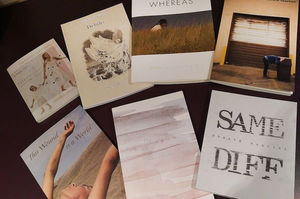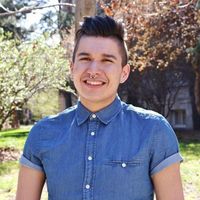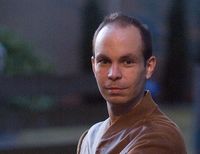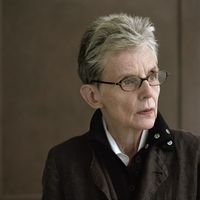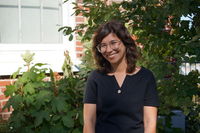"I Try to Find the Shape of a Poem" Talking to the Griffin Poetry Prize Finalists about Process & Poetry
When it comes to poetry, it doesn't get any bigger than the Griffin Poetry Prize. The two $75,000 prizes (one for a Canadian collection of poetry, one for an international collection) not only has one of the most significant prize purses in the world, but the some of biggest profile and impact on a writer's career as well. With past winners like Anne Carson, Paul Muldoon, and P.K. Page, the prizes' pedigree is singular in the poetry world and a nomination is a career-altering moment for a poet.
This year we have the pleasure of speaking to six of the seven talented poets who have experienced that moment: Tongo Eisen-Martin, author of Heaven is All Goodbyes (City Lights); Susan Howe, author of Debths (New Directions); Natalie Shapero, author of Hard Child (Copper Canyon Press), all of whom are nominated for the international prize; and Billy-Ray Belcourt, author of This Wound is a World (Frontenac House); Aisha Sasha John, author of I have to live (McClelland & Stewart); Donato Mancini, author of Same Diff (Talonbooks), nominated for the Canadian prize. Layli Long Soldier, author of Whereas (Graywolf Press), who is nominated for the international prize, was unavailable at press time.
Each of the finalists will receive $10,000 to honour the excellence of their collections. The two winners, to be announced at the Griffin Poetry Prize Awards on Thursday, June 7, will each be awarded an additional $65,000.
If you want to catch the Griffin Prize poets in person, tickets are available for the Shortlist Readings to be held on Wednesday, June 6 in Toronto. Full details are available here or by calling (416) 408-0208. You can also purchase an anthology of poems selected from the shortlisted books, published by House of Anansi Press.
In our conversation below, Natalie Shapero tells us about using a trivia question as a jumping off point for her collection (can you get it?), the poets each recommend a Canadian poetry collection they love, and Tongo Eisen-Martin tells us about "hanging on for dear life" during the writing process.
______________________________________________________________________
Open Book:
Tell us about your nominated collection and how the project originated for you.
Billy-Ray Belcourt:
This Wound is a World is a book that wasn’t conceived as a book, but as experiments in ways of seeing/unseeing that I undertook between the ages of 19 and 22. I didn’t write in the direction of a book, but was more than happy when my editor at Frontenac took a leap of faith to publish my poems, to invest in such a young writer who occupies multiple social loci. I then began to shape the book into something that might eschew the embargo on representation that has kept queer Indigenous art from the world. I wanted it to open up a world of possibility and recognition in those who might feel mired in the miseries of coloniality.
Tongo Eisen-Martin:
Heaven Is All Goodbyes is an excavation of sites of oppression and resistance in order to find new patterns of definition. There is a sub-whole or half-step beneath reality in which the million dualities above and possible single unity beneath cooperate and define each other. Poetry reveals that realm, and in that place, I wanted the poems of this collection to make their stand.
I also wanted to continue to explore the use of multiple narrators ranging from the relaxed sociologist to the raging dispossessed; from inanimate protagonists to the cautious condemned. I let trickster voices take responsibility for social analysis in order to see what insight comes when you dampen the self-importance of pain and linear perception of liberation.
All of the above being an extension of the quest to remove the dynamic of reward or intoxication from my writing process.
Your CanLit News
Subscribe to Open Book’s newsletter to get local book events, literary content, writing tips, and more in your inbox
Susan Howe:
Debths consists of five different sections. In one way it can be seen as the result of years spent exploring questions concerning editorial transcription and translation into print of original manuscripts. More specifically the work was inspired by seeing the visual artist Paul Thek's retrospective exhibition called Diver at the Whitney Museum in 2011. I've always been interested in folktales, splinter religious sects, lost languages, riddles, coincidence, chance connections, and here among many other examples of magical thinking, I was particularly moved by a series of small bronze sculptures scattered from room to room under a general title "The Personal Effects of the Pied Piper." Shortly after this I spent a month as an artist-in-residence at the Gardner Museum in Boston. Wandering among all the art objects Isabella Stewart Gardner had acquired and carefully arranged during the early years of the 20th century I began to think of her as a pioneer American Installation artist.
Aisha Sasha John:
It started with what is now its fourth section: “Rat vs. Lamb.” I was trying to feel my way out of understanding pure-heartedness and cunning as mutually exclusive.
Donato Mancini:
As a book, Same Diff started with the title, and with the perpetual poem that became its frontispiece. I thought it would be a book of short poems of similar form (list-like permutations of a clear variable), each of which answered the summons of the title in some direct way. During the final year of writing, the longer pieces gradually took over.
Natalie Shapero:
Much of Hard Child is interested in how we talk about difficult subjects by talking about entirely other topics – how do we use deflection or distraction or figurative language to address what we can’t address squarely? I wanted to write poems that evoked their obsessions and arguments by edging around them. The book takes its epigraph from the Cees Noteboom novel Rituals: “Memory is like a dog that lies down where it pleases,” and a number of the poems also aim to posit the past as having its own agency and logic – an agency and logic that is inaccessible to us, even as it constantly intersects our present lives.
OB:
Are there images, themes, or questions you notice recurring in your work? If so, what are they?
BB:
In an interview with the Banff Centre, I noted that “the world” was my unit of analysis for the book. The world has a few valences, at least: there is the world of coloniality, in which we are all caught; there are the worlds we move in and out of as a condition of daily life (the world of my small, downtown apartment, for example); then there’s the world-to-come, the one we perform in opposition to the here and now, if we have the diagnostics to identify its vulgarities. These are three scenes in the book that repeat and shape-shift.
TEM:
The city at the dusk of this epoch features heavily. Also heavily featured is the investigation of people of various relationships to struggle and confrontation of reality through their respective monologues. The conversational oppressor and oppressed in violent negotiation. I am heavy with people. Souls, their reductions, their leaders, organic intellectuals, survivors, and liars destroyed or redeemed. Implied precipices for people of a new day and the rest of us who will sink into the sand along with every other untenable part of these times dominate the foreground of a lot of the poems. The usual question involves liberation and our journeys in relationship to it.
SH:
Questions of originality and quotation. Wars. The sea. Crossings. Conversion. Translation. Dictionaries, libraries, local histories, public parks, abandonment, telepathy, wordplay. Over the last ten years my collaborations and performances with the musician/ composer David Grubbs have led me towards acoustic experiments in terms of noting alliterative sound patterns as double-edged sensory domains open for field recording.
ASJ:
What is grace?
DM:
O yes, many. Measurement. Evaluation. Repetition. Variation. Social and personal effects of capitalism. The interaction of systemic, symbolic and subjective violence. Food. Lists. Time. The clashing of different voices, different discourses. Reading itself as a physical activity and as a problem of acculturation. The alphabet in freedom. And more. No doubt others that I am unaware of.
NS:
The opening poem in the book is structured around a trivia question (which three countries are entirely inside of other countries?), and a number of the poems that follow revolve around or integrate similarly decontextualized inquiries or historical factoids. I’m very interested in pieces of knowledge that exist simply to attest to the phenomenon of certainty. This type of sheer correctness comes into the poems as a kind of foil for the opposing and unanswerable questions at the book’s core.
OB:
If you were to recommend just one Canadian poem (or poetry collection) to readers right now, what would it be and why?
BB:
Mercedes Eng’s Prison Industrial Complex Explodes. Eng is a documentarian of the everyday and its attendant and entangled forms of racialized violence. The book is ghosted by a host of source texts that Eng unleashes on the system that birthed them, and she is sly and exacting in doing this. Hers is a sociological eye that refuses singularity to illuminate how we are differently swept up in the Singularity that is carcerality. Always, she returns us to the “ground zero for a revolution.”
TEM:
Cecily Nicholson’s Wayside Sang is a collection of unfathomable genius. Unfathomable; similar to Thelonious Monk in that there is no way to figure out the circuitry of her mind’s output. I don’t think there is anyone doing to language what she is doing right now. Very exciting poems. And an unrivaled commitment to planet and humanity.
SH:
An early collection by Anne Carson called Glass, Irony, and God. It's an exemplary mixture of poetry, autobiography, and scholarship. Particularly the long opening poem "The Glass Essay," and the final essay "The Gender of Sound" which in 2018 seems prophetic and even more relevant.. In "Adagia" Wallace Stevens writes, "Poetry is the scholar's art." All Anne Carson's work over the years exemplifies this brilliant aphorism.
ASJ:
Mais I have to live, bien sur!
DM:
I find questions like this really difficult to answer, as I can’t imagine anyone else having the same reading needs as anyone else. So I’ll just recommend the last two Canadian books I read and liked, if you don’t mind. Aisha Sasha John’s I have to live. And Edward Byrne’s Duets. John’s book is brilliant in a number of ways, but what strikes me on first reading is how the poems dance through each other, independent but needing one another for the total effect. The book vibrates with hilarious energy. Because it’s one of those looks-easy-but-is-not-at-all-easy poetics, it could have a lot of imitators. Byrne’s book is totally unlike John’s. It compiles his in/errant translations of Louise Labé and Guido Cavalcanti. He seems to remove the skins of the originals yet keep them alive, conveying while inverting (not subverting) the originals. Judicious decisions all over the place – in both books.
NS:
To anyone who is interested in the sense of fractured self in the work of the artists, I recommend Dionne Brand’s soon-to-be-published The Blue Clerk. I was fortunate to hear her read from it earlier this year, and it is astonishing.
OB:
Tell us what a typical writing day (if such a thing exists for you) looks like while you're working on a collection.
BB:
Working on my sophomore book of poems, it looked like writing on an airplane in the “Notes” app of my iPhone, at the Banff Centre in a boat in the woods, at my mom’s kitchen table in northern Alberta – I like this refusal of habit.
TEM:
I typically put a timer on for two or three hours and just wade through the writing session. Sometimes I have music in the background to jumpstart the primary colour of the poems, but ultimately, I do not look to accomplish any thesis or state of mind. Usually I am hanging on for dear life hoping that the next line is just a little stronger than the last. Writing in many ways is just the art of beating writer’s block. A poem is just the remains of employed strategies; tricks I have learned along the way to stay one step ahead of an ever-looming calcification of my mind.
SH:
I'm a widow living alone and retired from teaching I spend most of my time (after being horrified and depressed by my breakfast reading of The New York Times) upstairs in my light filled workroom reading, taking notes, checking and continuing, sometimes deleting, what I did the day before. I write my poems in series. On my monitor I need to see the way one page relates to the next so there is a sense of mirroring I can't explain. Usually I begin by following some thread, an oddly spelled word, a name, a quotation, some clue, that leads me to the stacks in one of the university research collections not far from here where I love to roam. I consider wandering in libraries as a crucial process for all my writing. One thread or clue leads to another: The Pied Piper to Tom Tit Tot, Tom Tit Tot to Rumpelstiltskin. I started as a visual artist and my room is more like a studio: white walls, with high work tables all around and two rolling drafting chairs. On one table is my monitor, computer and printer with lots of open space to lay out the printed pages. That's where I catch mistakes and new possibilities. I can't think of working without a printer. On another table I have materials for word collages. Lots of my there work involves a scanner/ copier, scissors, and scotch tape. On another table I keep stacks of the books I have collected for whatever path I am exploring. I keep a large Webster's International Dictionary on a tall stand my husband made me years ago. I'm a workaholic. Vacations make me uneasy. But at the end of each afternoon I take a long walk out on land here that was once used for making wampum beads, then farming, then for quarrying the rare pink granite this area is known for. Now the working Quarry is long gone and it's mostly tidal salt marsh. My path leads to a rocky spot at the edge of Long Island Sound, where I sit on a pier and look at the water and sea birds. Guilford is a marvellous place for birdwatchers. I enjoy the particular changes each season brings; the tides and bird migrations, summer houses being closed and opened, and wonder about people who were here before. I think over what I've worked on that day and what changes I'll make in a line or a paragraph tomorrow. Back home after dinner I relax for an hour by streaming an episode from some series on TV (this evening from The Handmaid's Tale) and realize how lucky I am to be still living and working.
ASJ:
Since January 2009, the only time I haven’t been consciously working on a collection is the month immediately after publishing one. I love writing—it’s part of how I live. So, no there’s no typical writing day—there’s just life.
DM:
It looks like me trying to straighten out a hairball of scribbles with my fingers and eyelashes daubed with Elmer’s glue while the fire alarm is going off because beans I have on the stove are starting to burn.
NS:
I think my writing practice is keyed to books, rather than to days. I spend a lot of time reading and making notes. That part mostly happens in fits and starts, at night with the window open listening to the train. Right now I’m reading a book about aging, a book about luck, and a book about cruelty. At some point I’ll block off a run of hours during the day, over a few days, to sit down with the notes and compare them with others I’ve made – on memories, senses, urgencies, oppositions. Then I try to find the shape of a poem somewhere in there, and then I write it.
_______________________________________
Billy-Ray Belcourt is from the Driftpile Cree Nation. He is a Ph.D. student at the University of Alberta, and a 2016 Rhodes Scholar who holds a M.St. in Women’s Studies from the University of Oxford. In 2016, he was named one of six Indigenous writers to watch by CBC Books, and was the winner of the 2016 P.K. Page Founder’s Award for Poetry. His work has been published in Assaraus: A Journal of Gay Poetry, Decolonization, Red Rising Magazine, mâmawai-âcimowak, SAD Mag, Yellow Medicine Review, The Malahat Review, PRISM International, and The Next Quarterly.
Tongo Eisen-Martin’s previous book, the critically acclaimed someone’s dead already (2015) was nominated for a California Book Award, and his poetry has been featured in Harper’s Magazine. He is also a movement worker and educator who has taught in detention centres from New York’s Rikers Island to California county jails. He has been a faculty member at the Institute for Research in African-American Studies at Columbia University, and his curriculum on the extrajudicial killing of Black People, “We Charge Genocide Again!”, has been used as an educational and organizing tool throughout America. He lives in San Francisco, California.
Author of more than a dozen books of poetry and two of literary criticism, Susan Howe’s recent collection of poems That This won the Bollingen Prize in 2011. Howe held the Samuel P. Capen Chair in Poetry and the Humanities at the State University New York at Buffalo until her retirement in 2007. The recipient of a Guggenheim Fellowship, she was elected to the American Academy of Arts and Sciences in 1999 and served as a Chancellor to the Academy of American Poets between 2000-2006. In 2009 she was awarded a Fellowship to the American Academy at Berlin. Recently, she was an Artist In Residence at the Isabella Stewart Gardner Museum in Boston. Howe has also released three CDs in collaboration with the musician/composer David Grubbs, Thiefth, Souls of the Labadie Tract, and Frolic Architecture. In 2013 her word collages were exhibited at the Yale Union in Portland, Oregon, and in the Whitney Biennial Spring, 2014. Most recently, a limited press edition of Tom Tit Tot (word collages which amount to a series poem) with artwork by R. H. Quaytman has been published by MoMA in New York, and Spontaneous Particulars: The Telepathy of Archives by Christine Burgin and New Directions.
Aisha Sasha John is a poet, dancer and choreographer. Her solo performance ‘The Aisha of Oz’ premiered at the Whitney Museum in New York in 2017. Another iteration of the show will take place at the MAI in Montreal in 2018. Her previous poetry collection, Thou (2014), was a finalist for both the Trillium Book Award for Poetry and the ReLit Poetry Award. In addition to her solo work, she has choreographed, performed, and curated as a member of the performance collective WIVES. Aisha’s video work and text art have been exhibited in galleries and public installations. Born in Montreal, Aisha has an MFA in Creative Writing from the University of Guelph, and a B.A. in African Studies and Semiotics from the University of Toronto.
The interdisciplinary practice of Donato Mancini focuses mainly on poetry, bookworks, text-based visual art and cultural criticism. His books and chapbooks include Snowline (2015), Loitersack (2014), Buffet World (2011), Fact ‘N’ Value (2011), Hell Passport no.22 (2008), Æthel (2007), 58 Free Coffees (2006), and Ligatures (2005). Ligatures and Æthel were each nominated for the ReLit Poetry Award, and Ligatures received honourable mention in the Alcuin Society book design awards. Mancini’s published critical writing includes work on the archive, time, and memory in Anamnesia: Unforgetting (2011), and a discourse analysis of poetry reviews in You Must Work Harder to Write Poetry of Excellence (2012). He holds a Ph.D. in English from the University of British Columbia.
Natalie Shapero is the Professor of the Practice of Poetry at Tufts University and an editor at large of the Kenyon Review. Her first poetry collection, No Object, was published by Saturnalia Books in 2013. Natalie’s writing has appeared in publications such as The Nation, The New Republic, The New Yorker, Poetry, and The Progressive. She holds degrees in creative writing and in law and has worked as a litigation fellow with Americans United for Separation of Church and State. Her awards include a National Endowment for the Arts Fellowship, a Ruth Lilly Fellowship, a Kenyon Review Fellowship, and a Great Lakes College Association New Writers Award.
